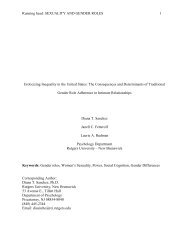Sources of self-categorization as minority for mixed race individuals
Sources of self-categorization as minority for mixed race individuals
Sources of self-categorization as minority for mixed race individuals
You also want an ePaper? Increase the reach of your titles
YUMPU automatically turns print PDFs into web optimized ePapers that Google loves.
<strong>Sources</strong> <strong>of</strong> Self-Categorization 5Brunsma, 2002; Sanchez, Shih, & Garcia, 2009). This work examines state or momentaryfluctuations in <strong>self</strong>-<strong>categorization</strong> among multiracial people rather than trait <strong>self</strong>-<strong>categorization</strong>.Like “trait” <strong>self</strong>-esteem, “trait” <strong>categorization</strong> can be thought <strong>of</strong> <strong>as</strong> the racial <strong>categorization</strong> that amultiracial person h<strong>as</strong>, resulting from repeated <strong>self</strong>-<strong>categorization</strong>s made over a long period <strong>of</strong>time. In the present paper, we focus on identifying what factors contribute to trait racial <strong>self</strong><strong>categorization</strong>.<strong>Sources</strong> <strong>of</strong> Minority Self-CategorizationWhat some SIT and SCT theorists would consider the byproducts <strong>of</strong> <strong>self</strong>-<strong>categorization</strong>(perceived similarity to the ingroup, connectedness to the ingroup; Hogg, 2004; Hornsey, 2008;Postmes & Spears, 1998; Tajfel, 1981; Turner, 1991) may also serve <strong>as</strong> predictors or sources <strong>of</strong><strong>minority</strong> <strong>categorization</strong> <strong>for</strong> multiracial people. Indeed a recent review <strong>of</strong> Latino psychologysuggests that both ethnic socialization and physical appearance impact development <strong>of</strong>monoracial Latino identity (Quintana & Scull, 2009).Little research details either thepsychological factors that serve to in<strong>for</strong>m multiracial <strong>individuals</strong>’ racial <strong>categorization</strong>, or thepsychological effects <strong>of</strong> racially categorizing one<strong>self</strong> <strong>as</strong> <strong>minority</strong> <strong>as</strong> opposed to White (<strong>for</strong> part-White multiracial <strong>individuals</strong>).Multiracial people <strong>of</strong> White and <strong>minority</strong> descent have two racial ingroups: their <strong>minority</strong>ingroup and their majority ingroup. We propose that <strong>for</strong> these <strong>individuals</strong>, feeling more similar tothe <strong>minority</strong> group predicts <strong>self</strong>-categorizing with the <strong>minority</strong> group. Self-perceived similarityin this c<strong>as</strong>e, can be thought <strong>of</strong> <strong>as</strong> similarity to a prototypical representation <strong>of</strong> a category, orracial group. The cognitive conception <strong>of</strong> prototypes <strong>as</strong>serts that <strong>for</strong> any particular category,there exists in memory an abstract instance <strong>of</strong> that category that best represents the group(Lack<strong>of</strong>f, 1987; Rosch, 1975). Psychologists have there<strong>for</strong>e hypothesized that the similarity



